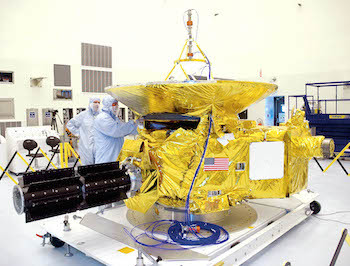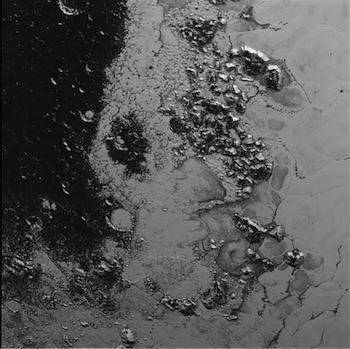Pluto, which for many years was considered the ninth lanet in our solar system, was officially discovered in 1930. Thousands of suggestions were put forward as to what this new planet should be named, but eventually an eleven-year-old girl's suggestion of "Pluto," the name of the god of the underworld in classical mythology, was adopted.
Pluto's Planetary History
Because of Pluto's distance from our planet, it has historically proved difficult for astronomers to either clearly see it or even guess its mass. Over the years, scientists have discovered that Pluto is quite small, about one-sixth the mass of our own moon. In the 1990s, astronomers also discovered that Pluto is surrounded by several objects of similar size. This sparked controversy as to whether or not Pluto should be fully considered a planet at all.
 Check out this colored version of one of the closest ever images of Pluto!Courtesy of NASA
Check out this colored version of one of the closest ever images of Pluto!Courtesy of NASA
In August 2006, the International Astronomical Union defined the terms by which an object may be called a planet, and Pluto failed to fall within those terms. Thus, Pluto became known as a dwarf planet rather than the ninth planet in our solar system.
Pluto Makes News
Though it's been nearly 10 years since Pluto lost its planet status, the dwarf planet is making news again now as NASA releases the first ever seen photos showing images of the planet's surface. In July 2015, NASA's New Horizons space probe completed the 9-year journey to Pluto, where it took the most detailed pictures of the planet that scientists have ever seen.
 Scientists working on the New Horizons space probeCourtesy of NASA
Scientists working on the New Horizons space probeCourtesy of NASA
Scientists know that Pluto is made up of ice and rock, and its distance from the sun means that it is constantly bathed in a kind of twilight. Astronomers have learned a few new things from the New Horizons probe, though!
Mountains and Craters
Scientists discovered some big surprises in New Horizon's images of Pluto. One of these was the existence of an 11-thousand-foot-high mountain range on Pluto's surface. This mountain range is likely no more than 100 million years old, making it relatively young for our solar system. Scientists are will unsure what is behind this geological activity - because of Pluto's size and placement in the solar system, mountains would not form in the same way that they would on Earth or on a moon or larger planet.
 These are the first ever images of Pluto's mountain range!Courtesy of NASA
These are the first ever images of Pluto's mountain range!Courtesy of NASA
Astronomers base their assumption that the mountain range has (fairly) recently formed and may still be forming on the fact that the area shows very little evidence of craters. Much of the rest of Pluto is cratered, suggesting that the dwarf planet has been hit many times by space debris. However, with no such craters around the mountain range, scientists believe that the surface structure has had a geological "face lift" in the time since craters pockmarked Pluto's surface.
 Pluto, backlit by the sunCourtesy of NASA
Pluto, backlit by the sunCourtesy of NASA
The leaps and bounds that we are making in exploring our solar system are truly amazing. In the next few decades, it seems like we can look forward to learning more and more about our world and universe!
Have Your Say!
Some astronomers would like to see Pluto reinstated as a full planet. What do you think?
































